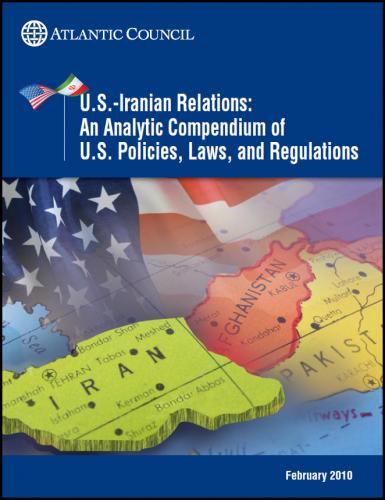This Compendium contains the text of major regulations, laws, and other documents governing U.S. interactions with Iran. Also provided are the text of U.N. Security Council Resolutions, agreements between Iran and several other countries on various issues, and other documents that represent major policy decisions in U.S. relations with Iran. The publication was launched at an Atlantic Council panel discussion on U.S.-Iran relations.
Executive Summary:

As shown in the Compendium, changes in U.S. sanctions over time appear to reflect the lack of a clear consensus on how to curb the strategic threat Iran is widely considered to pose to U.S. interests in the Middle East, as well as responses to changes in Iran’s elected governments. At times, U.S. and international policy signals an openness to engagement with Iran, but at other times U.S. and international policy have appeared designed to try to isolate Iran to the extent possible. For example, the U.N. Security Council Resolutions presented in this Compendium convey not only the punishments for noncompliance but also the incentives for Iran to cooperate with the international community on its nuclear program.
Iran is an adversary not only of the United States, but also of several major countries in the Middle East. Most notable among these countries is Israel, but Iran has also been at odds with Saudi Arabia, the other Persian Gulf states, and Egypt. A U.S. decision to normalize relations with Iran would likely involve consultations with these countries, as well as with the European countries, for example, which have been part of the multilateral efforts to curb Iran’s nuclear program. This Compendium does not include sanctions laws and regulations imposed unilaterally by other countries.
Iran is subject to a wide range of U.S. sanctions. However, the laws and regulations contained in the Compendium are not all Iran-specific. Many of the laws that apply to Iran do so because of its designation, under section/paragraph 6(j) of the Export Administration Act of 1979, as a state sponsor of terrorism. As such, these sanctions apply similarly to other countries on the “terrorism list.” Iran was placed on the terrorism list in January 1984, a few months after the bombing in October 1983 of the Marine barracks in Beirut by Iran’s ally, Hezbollah, killing 241 Marines.
Perhaps the most sweeping U.S. sanction on Iran is the ban on U.S. trade with and investment in Iran. However, the trade ban is no longer comprehensive, as a result of modifi cations in 1999 and 2000. These modifi cations, which permit licensing of humanitarian exports to Iran and of importation into the United States of certain Iranian luxury goods, have enabled bilateral trade to reach about $800 million in 2008, with about two-thirds of that figure consisting of U.S. exports to Iran.
Many of the sanctions documents presented in this Compendium are incorporated into Title 31 of the Code of Federal Regulations. The major portions of the regulations that apply to Iran are included in the Compendium. The regulations are administered by the U.S. Treasury Department’s Offi ce of Foreign Assets Control, which is responsible for evaluating and issuing specifi c licenses, when required, for commerce and fi nancial transactions with Iran.
Included in this Compendium are laws and Executive Orders that establish so-called “secondary sanctions” against Iran – sanctions on companies of foreign countries that trade with or provide assistance to Iran. Most of these secondary sanctions apply to companies that sell advanced technology to Iran that can be used in Iran’s weapons of mass destruction (WMD) programs. One key secondary sanction is the Iran Sanctions Act (ISA), first adopted in 1996 and amended several time since. It provides for sanctions on companies that develop Iran’s energy sector, for example by drilling for oil and gas and extracting these resources. Secondary sanctions authorize U.S. penalties against foreign companies’ interests in and business with the United States, thereby attempting to force these firms to choose between doing business with Iran or doing business in the much larger U.S. market. As such, secondary sanctions laws are widely criticized by U.S. allies and other governments as an extra-territorial application of U.S. law.
Successive U.S. Administrations have been hesitant to impose actual penalties against companies incorporated in allied countries, particularly when those companies are involved only in Iran’s civilian economy. This hesitancy has been created by the likelihood of diplomatic backlash by U.S. allies, whose adverse reactions to imposition of penalties against their companies might undermine U.S. efforts to build international consensus against Iran. U.S. Administration decisions might also have been motivated by concerns about sparking legal challenges in the WTO to any U.S. imposition of extraterritorial sanctions.
There has been substantially less hesitancy to penalize companies that sell weapons of mass destruction and arms related technology to Iran. A large number of foreign companies, including many from Russia, China, and North Korea, but also from U.S. allies such as India and Taiwan, have been penalized. The full list of penalized companies is too extensive to present in this Compendium, but can be found on the website of the Department of the Treasury.
Related Events:
- U.S.-Iran Relations: Best-Case Scenario
- Iran: Engagement or Regime Change?
Related New Atlanticist Analysis:
- Iran Sanctions: Failing But Multiplying – James Joyner
- Iran: China 1972 or Russia 1987? – James Joyner
